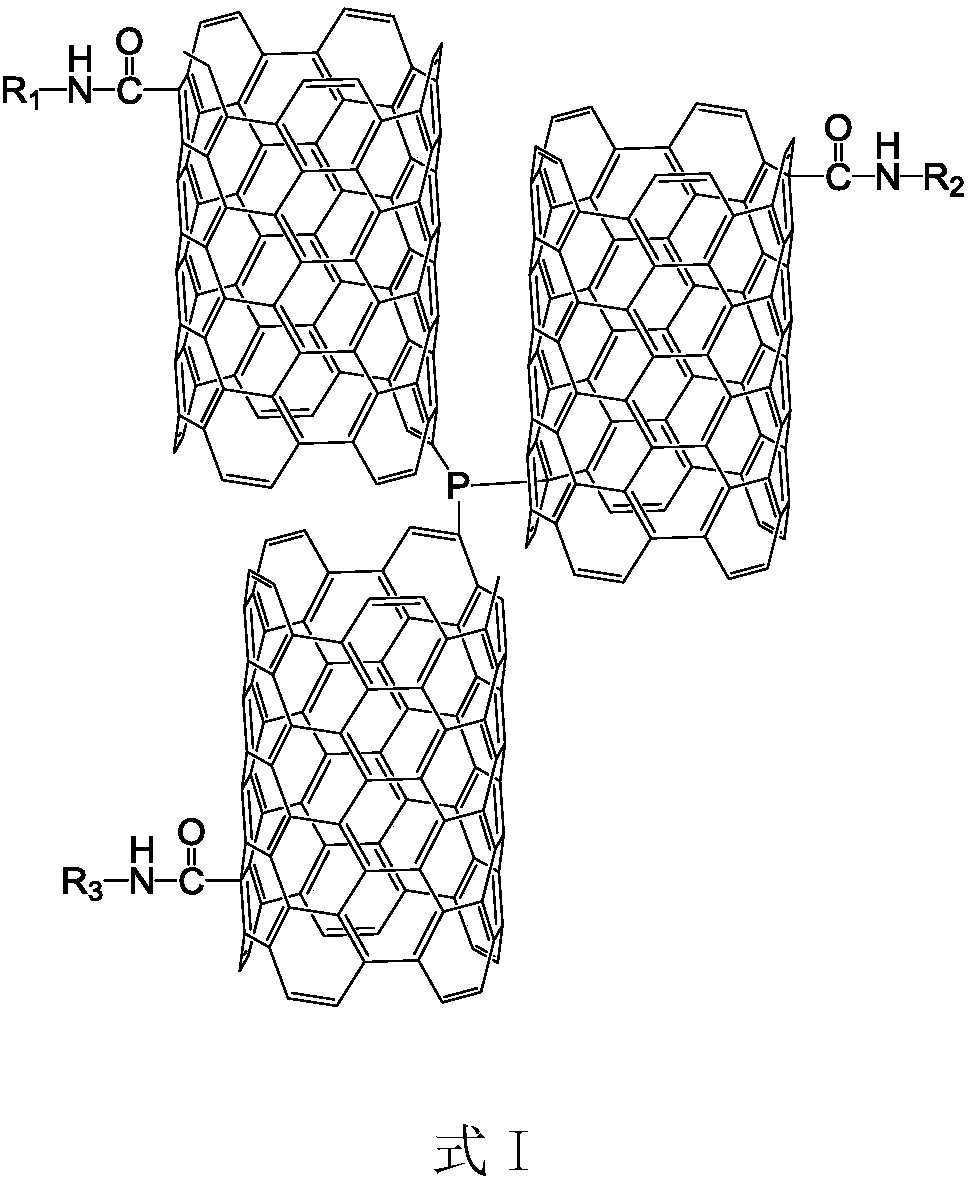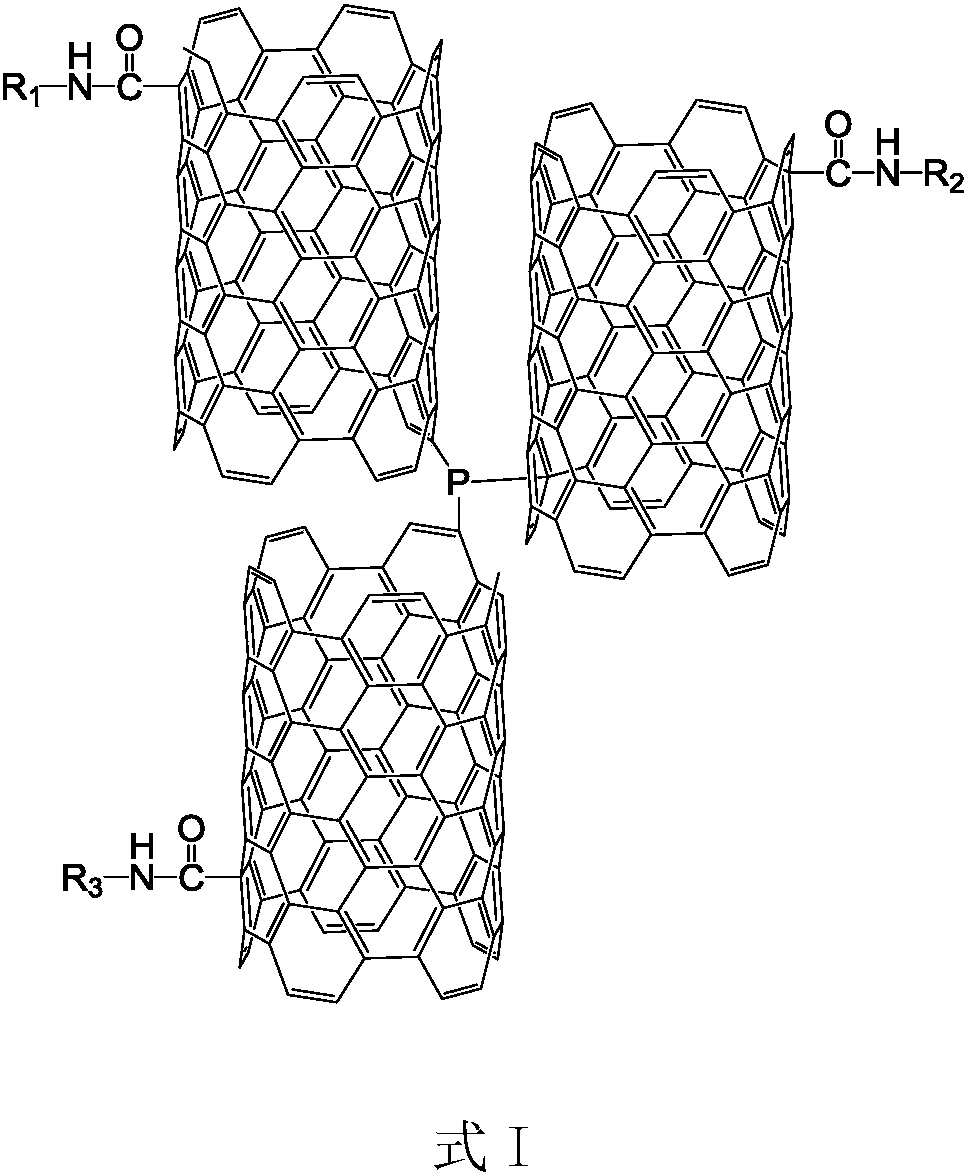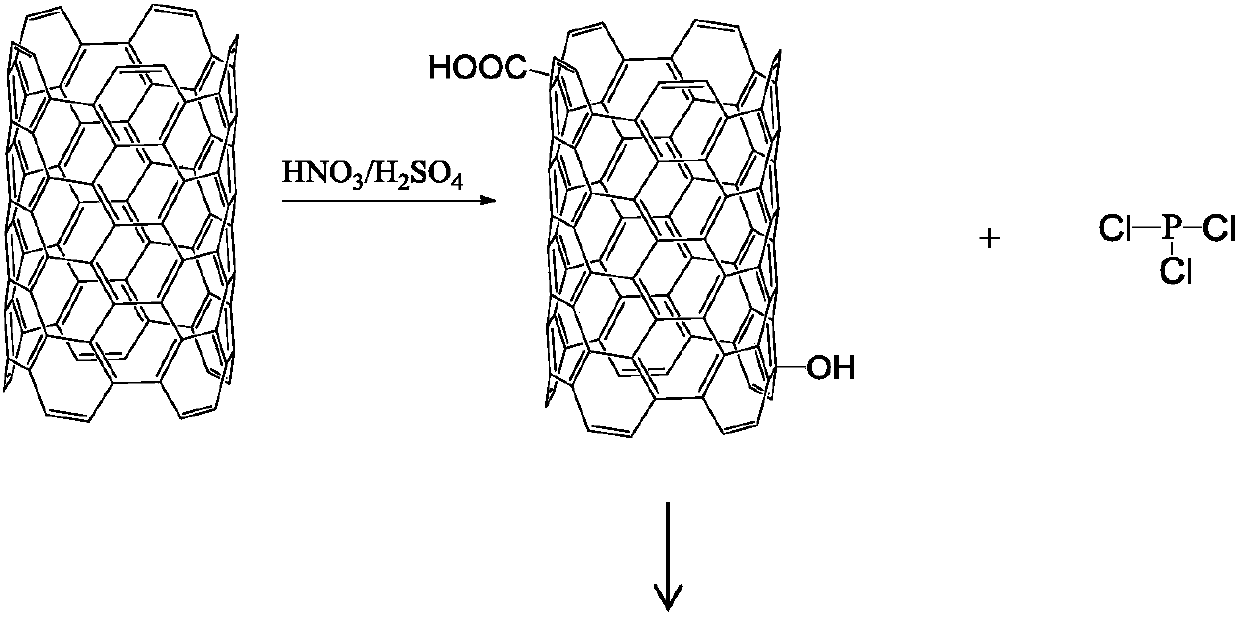Epoxy resin fire retardant and preparation method thereof, as well as epoxy resin composition prepared from fire retardant
A technology of epoxy resin and flame retardant, which is applied in the field of epoxy resin composition, epoxy resin flame retardant and its preparation, can solve problems such as environmental pollution, reduction of material mechanical properties, migration and precipitation of flame retardant, and achieve Solve environmental pollution problems, good synergies, good environmental effects
- Summary
- Abstract
- Description
- Claims
- Application Information
AI Technical Summary
Problems solved by technology
Method used
Image
Examples
Embodiment 1
[0082] (1) Preparation of flame retardant
[0083] ①Add 2g of single-walled carbon nanotubes to an Erlenmeyer flask filled with 45ml of mixed acid of 98wt% concentrated sulfuric acid and 68wt% concentrated nitric acid (volume ratio 1:3), ultrasonicate at 50°C for 3 hours, and then wash repeatedly with deionized water , drying in a vacuum oven at 80°C for 12h to constant weight to obtain acidified carbon nanotubes;
[0084] ② React the acidified carbon nanotubes obtained in (1) with a molar ratio of 1:5 and phosphorus trichloride at 125°C for 3 hours to obtain phosphite-modified carbon nanotubes.
[0085] ③ Mix 100 g of phosphite-modified carbon nanotubes obtained in (2) with 0.3 g of aluminum trichloride evenly, raise the temperature to 150 ° C, react for 5 h, and collect fractions with an absolute pressure of 0.1 MPa and a temperature of 177 ° C.
[0086] ④ Mix the distillate obtained in (3) with melamine at a molar ratio of 1:2.6, and react at 30°C for 4 hours; to obtain th...
Embodiment 2
[0097] (1) Preparation of flame retardant
[0098] ①Add 2g of single-walled carbon nanotubes to an Erlenmeyer flask filled with 45ml of mixed acid of 98wt% concentrated sulfuric acid and 68wt% concentrated nitric acid (volume ratio 1:2.5), ultrasonicate at 40°C for 3 hours, and then wash repeatedly with deionized water , dried in a vacuum oven at 85°C for 10h to constant weight to obtain acidified carbon nanotubes;
[0099] ② React the acidified carbon nanotubes obtained in (1) with a molar ratio of 1:3 and phosphorus trichloride at 140°C for 3.5 hours to obtain phosphite-modified carbon nanotubes.
[0100] ③ Mix 100 g of phosphite-modified carbon nanotubes obtained in (2) with 0.5 g of aluminum trichloride evenly, raise the temperature to 205° C., react for 5 hours, and collect fractions with an absolute pressure of 0.09 MPa and a temperature of 175° C.
[0101] ④ Mix the fraction obtained in (3) with o-phenylenediamine at a molar ratio of 1:3, and react at 35°C for 4 hours;...
Embodiment 3
[0112] (1) Preparation of flame retardant
[0113] ①Add 2g of single-walled carbon nanotubes to an Erlenmeyer flask containing 45ml of mixed acid of 98wt% concentrated sulfuric acid and 68wt% concentrated nitric acid (volume ratio 0.9:2.5), ultrasonicate at 70°C for 3 hours, and then wash repeatedly with deionized water , dried in a vacuum oven at 85°C for 10h to constant weight to obtain acidified carbon nanotubes;
[0114] ② React the acidified carbon nanotubes obtained in (1) with a molar ratio of 1.5:9.5 and phosphorus trichloride at 125° C. for 3.5 hours to obtain phosphite-modified carbon nanotubes.
[0115] ③ Mix 100 g of phosphite-modified carbon nanotubes obtained in (2) with 0.3 g of magnesium chloride, heat up to 150° C., react for 12 hours, and collect fractions with an absolute pressure of 0.09 MPa and a temperature of 175° C.
[0116] ④ Mix the fraction obtained in (3) with m-phenylenediamine in a molar ratio of 0.8:3, and react at 30°C for 5 hours; to obtain th...
PUM
| Property | Measurement | Unit |
|---|---|---|
| Total heat release | aaaaa | aaaaa |
Abstract
Description
Claims
Application Information
 Login to View More
Login to View More - R&D
- Intellectual Property
- Life Sciences
- Materials
- Tech Scout
- Unparalleled Data Quality
- Higher Quality Content
- 60% Fewer Hallucinations
Browse by: Latest US Patents, China's latest patents, Technical Efficacy Thesaurus, Application Domain, Technology Topic, Popular Technical Reports.
© 2025 PatSnap. All rights reserved.Legal|Privacy policy|Modern Slavery Act Transparency Statement|Sitemap|About US| Contact US: help@patsnap.com



